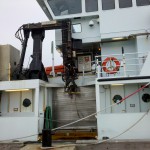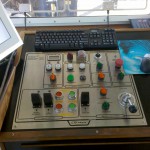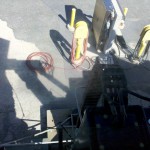One of the interesting innovations on the RV Hugh R Sharp is the incorporation of a “CTD Handling System” from Caley Ocean Systems. The video above was taken from the wet lab of a CTD Rosette being deployed and recovered using this system. If you search around on YouTube, you can find some interesting videos of crews deploying and recovering the CTD Rosette system. What you typically find is that you have one crane operator and then two or three crew members on deck with poles and/or ropes to try and guide the CTD back onto the deck. With the ship rocking and rolling out to sea, this can be a tad dangerous, especially when much of this work is done close to the waterline with waves splashing on deck.
The RV Hugh R Sharp has a CTD handling system that is pretty much designed to be operated by one marine technician, one of two currently in use in the UNOLS fleet (the other is on the RV Kilo Moana).
The marine technician on the Sharp is up on the bridge level and looks down through windows at the wet lab area and beside the ship. This allows them to control the deployment and the recovery of the CTD from a much safer location. The Caley CTD Handling System has motion compensation built in to cancel out the roll and pitch of the ship and is designed to mostly eliminate the swaying of the CTD system. This makes for a much smoother and safer CTD deployment and recovery, which can occur quite often on many research vessels. The following pictures show the control station up on the bridge and an exterior view of the Caley CTD Handling System onboard the Sharp.
Next time I’m out on the Sharp, I’ll try to get a view of the system in action from outside the wet lab.
Is the system perfect? No, they still have some kinks to work out and with Caley located over in the UK, turn-around time can be pretty slow at times. The vessel operators are taking some lumps and trying to iron the kinks out of a system that can help make it a little safer to do routine underway CTD casts. Their efforts should be applauded.



